Abstract
The hard rock stratum will seriously affect the efficiency of deep-sea drilling and greatly increase the cost of drilling operations due to its complexity. In ocean drilling operations, the design of the bit is critical. Therefore, the core bit should be able to drill in a variety of formations, especially in hard rock stratum, with the function of reducing the need to change the bit due to formation changes and improving the drilling efficiency. In this paper, three different core bits were designed according to the hard rock stratum of the seabed: the roller bit, diamond bit and bionic bit. According to the test results, it was observed that: (1) It is fully proven that the roller core bit has the characteristics of stable drilling in hard strata, small torque and high drilling efficiency. The same method can realize the core in shallow soft strata through the setting of drilling parameters. (2) For the diamond bit, the field test data show that the new formula diamond bit has a good adaptability to the changing hard rock strata in this area, with an average rate of penetration (ROP) of 4.4 m/h and a bit life of 137.75 m. (3) For the bionic bit, field experiment data showed that drilling in the formation lithology was gray green tuff, which had a core recovery up to 100%. The average ROP was 1.35 m/h, and the highest ROP was 1.88 m/h. The design and experiment of three kinds of drill bits have effectively solved the technical problem of efficient drilling in deep-sea hard-rock stratum.
1. Introduction
The land area of the world is less than 30% of the earth’s surface area, and the rest is the ocean. Of which, more than 60% of the deep-sea areas have depths greater than 2000 m. Regarding the sustainable development of the earth, research solely on land is no longer sufficient. Therefore, more research on the deep sea is necessary [1,2,3]. Through studying the deep sea, many marine science issues could be solved, such as exploring the mysteries of the deep sea, understanding the expansion of the sea floor, exploring the origin of the continental mountain systems, interpreting the sedimentary processes in the sea floor, and determining the root of climate evolution. Ocean drilling is the only method of directly obtaining the physical data on deep earth [4,5].
Since the U.S. launched the Deep-Sea Drilling Program (DSDP) in 1968, it has grown into an international program. In addition, the Ocean Drilling Program (ODP), Integrated Ocean Drilling Program (IODP), and International Ocean Discovery Program (IODP) have since been implemented successively [6]. According to the statistical analysis of the data from the Deep Ocean Drilling Program (DSDP) to the International Ocean Discovery Program (IODP), from August 1968 to July 2021, the total depth of international ocean drilling was 1,016,901 m, and the cumulative depth of bedrock (hard rock) drilling was about 39,724 m, with 3.9% of the total depth [7,8].
The ROP (rate of penetration) and bit life are closely related to formation conditions. Both the ROP and bit life indicators are high in sediments, with the ROP generally varying between 5–30 m/h, and the bit life up to about 1500 m (Table 1). In hard crystalline rocks (principally igneous rocks), the ROP is typically 1–3 m/h and the bit life is 20–100 m (Table 2). The bit life and ROP both decrease when the depth of the hole increases, which means drilling becomes more difficult at deeper depths [9].

Table 1.
The ROP and bit life for deep holes in sediments in international ocean drilling (data were from preliminary report for each DSDP, ODP and IODP expedition).

Table 2.
The ROP and bit life of several hard rock deep holes in international ocean drilling (data were from preliminary report for each DSDP, ODP and IODP expedition).
Among all the efficiency parameters in hard rock drilling, the ROP was significantly more influential on the drilling cost than the other parameters. There are many factors affecting the ROP. In addition to the objective factors of formation, other factors will have an impact on the ROP, such as the weight of bit (WOB), revolutions per minute (RPM), the selection of the bit, mud-carrying capacity and so on. For example, an increase in the WOB generally leads to an increase in the ROP, but a high WOB can also cause the bit to wear out quickly, which could increase the cost of drilling. An increase in the WOB can also cause severe deformation of the drill pipe beyond its longitudinal bending load. As for drill bits, different types of bits can be used in different formations. Choosing the right bit could lead to a higher ROP and a longer bit life. As for the RPM, an increase in the RPM generally increases the ROP, but it also decreases the ROP when the contact time of the bit teeth and the layer is less than the contact time of breaking the rock. As for the drilling mud, an increase in density, viscosity and the solid content of drilling mud would also reduce the ROP. However, the most immediate and critical factor is the drill bit [10,11,12]. The ideal drill bit should have high rock-crushing efficiency, a long service life and good core protection [13].
To this end, the researchers of the project team designed three different kinds of core bits based on the hard rock stratum of the seabed. Namely, they were the roller core bit, diamond core bit and bionic core bit. In order to solve the problem of the ROP and the drilling life of the drill bit during deep-sea drilling in hard rock stratum, the drilling rates and drilling lives of three kinds of hard rock bits were studied.
2. Roller Core Bit
Because of the advantages of a wide range of adaptations to the formation, high drilling efficiency and long life, the roller core bit is used as the main rock-crushing tool. Among them, the shape structure, size, layout of teeth, layout of diameter retaining teeth, seal, bearing and lubrication form of the roller bit will affect the efficiency and service life of the core bit [14,15].
2.1. Design of Roller Core Bit
According to the technical requirements of deep-sea drilling and the structural parameters of the drilling rig [2,9], the core diameter of Φ70 mm is finally determined, and the diameter of the core tube and water outlet is Φ95 mm. At the same time, the selection of the tooth palm was carried out according to the investigation and application experience, including the cusp tooth type, sliding bearing, composite seal, lubrication compensation and layout of the full-face tooth. The tooth palm adopts the meshing design of the four-tooth palm, and all the teeth were adopted with the densest arrangement, including the cutting teeth, the outer-row teeth and the back-roller teeth [16]. The four nozzles were designed on the cutting direction, which could effectively improve the service life of the tooth palm (Figure 1). At the same time, a total of 104 cutting teeth, 49 outer-row teeth and 49 back-roller teeth were designed [17,18].
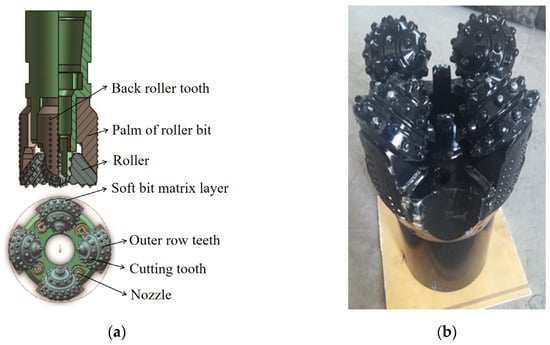
Figure 1.
(a) Three-dimensional-schematic diagram of roller core bit (scale: 1:3); (b) The solid body drawings of roller core bit.
2.2. Test Process of Roller Core Bit
During the land test of the roller core bit, the core test was carried out a total of eight times; the experimental data are shown in Table 3. Different WOB, RPM and flow rates were tested. In the test, a small WOB and a low RPM were used to drill at the beginning. The WOB is gradually increased to six-to-eight tons during normal drilling. Thereafter, the WOB and rotational speed are adjusted according to the type of core and the ROP. The WOB is generally not more than 10 tons [16].

Table 3.
Statistics on bit-drilling efficiency of roller core bit.
The data were shown in Figure 2. As the WOB and ROP increased, the ROP would continue to increase. When the WOB was 8 tons and the RPM was 66 r/min, the drilling efficiency reached 2.48 m/h. In the actual coring process, it was relatively smooth drilling in granite, and it was found that the core was seriously damaged by extrusion in the middle and rear sections (Figure 3).

Figure 2.
Data of roller core bit: (a) The ROP changes under different WOB; (b) The ROP changes under different RPM.
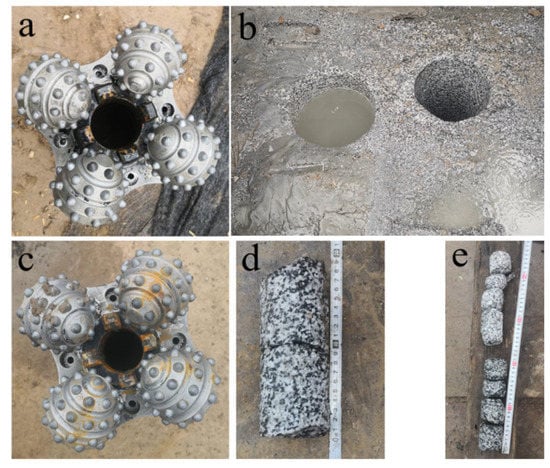
Figure 3.
Test photos of roller core bit: (a) Photos of drill bit before test; (b) Drill bit wear after test; (c) Drilling into holes during the test; (d,e) Obtained core samples.
After the completion of the test, the optimized design of the roller core bit was carried out. The palm of the roller bit adopted the four-palm meshing design, with the tooth palm cutting teeth, the outer-row teeth and the back-roller teeth encryption arrangement. Four nozzles were designed at the cutting direction, which effectively improved the service life of the tooth palm. The improved bit has the following advantages: (a) Increase the cutter layout density and prolong the service life; (b) The inner diameter protecting teeth are changed into composite teeth to ensure the strength of diameter protecting teeth; (c) Increase the core alignment height to the compound teeth to improve the core integrity.
2.3. Test Results of Roller Core Bit
Later, the sea test of the optimized roller core bit was carried out (Figure 4). The feasibility and reliability of the technology were fully verified by using the roller core bit to drill in deep-sea drilling. The test results showed that the roller core bit had strong adaptability and was suitable for shallow soft sand layers, clay layers, strong weathering and weak weathering layers. These things considered, the following conclusions could be obtained: (1) When the flow rate and RPM were constant, the WOB increased from 6 t to 7 t, and the ROP increased from 1.64 m/h to 2.07 m/h, which significantly increased the ROP; (2) When the WOB and the flow rate were constant, the RPM increased from 45 rpm to 55 rpm, and the ROP increased from 1.4 m/h to 1.64 m/h, thus increasing the ROP; (3) It was fully proven that the roller core bit could adapt to the drilling requirements of the full hole section of sand, clay, strong weathering and hard rock. The roller core bit had the characteristics of stable drilling in hard strata, small torque and high drilling efficiency, and it could realize the core of shallow soft strata through the setting of drilling parameters.
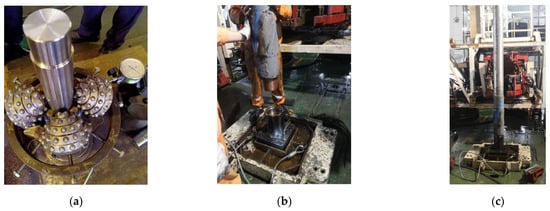
Figure 4.
(a) Optimization of roller core bit; (b) Installation of the roller core bit in the sea test; (c) Sea test of the roller core bit.
3. Diamond Core Bit
Although the drilling efficiency and service life were taken into account when using the roller core bit, the quality of the core is poor, and the recovery rate of the core is low. Therefore, in order to improve the core quality and the recovery rate, it is necessary to carry out research on diamond core bit technology for drilling hard rock strata such as carbonated rock crusts and sedimentary rock with hard flint interlayers [19,20].
3.1. Design of Diamond Core Bit
Aiming at the deep-sea hard rock stratum, the bottom-flat shape was selected as the main lip shape of the bit, which was conducive to fracturing the bottom rock. On this basis, the bottom of the bit was designed as a cusp concentric-circled or a cusp-staggered shape [21], as shown in Figure 5. The impact resistance and fatigue load resistance of the diamond working layer and the influence of the water inlet structure on the strength of the diamond working layer were fully considered in the structural design. To solve the problem of short bit life, the optimization research on the height of the working layer of the body matrix was carried out through the structural design of multi-layer eccentric helical teeth, the misalignment-type water trough, the transition-cutting working layer (Figure 6), etc. [22,23]. The height of the working layer of the body matrix was maximized to ensure the strength and impact resistance of the body matrix. In addition, the formulation study of the drill matrix with 5% tungsten carbide and 0.8% nano-rare earth was completed by the researchers of the project team [24,25].

Figure 5.
Schematic diagram of lip structure of diamond drill bit. (a) Bottom-flat shape; (b) Cusp concentric-circled shape; (c) Cusp-staggered shape.
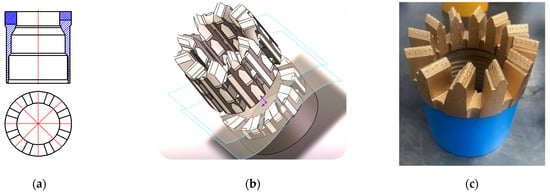
Figure 6.
Schematic diagram of diamond drill bit. (a) Side view and top view of diamond core bit; (b) 3D-schematic diagram of diamond core bit (scale: 1:4); (c) The solid body drawings of diamond core bit.
3.2. Test Process of Diamond Core Bit
The diamond core bit was tested in hard rock drilling test in Pingdu Hole 28ZK5, Pingdu City, Shandong Province. The strata were a little complicated. At the depth 0 to 61 m, the strata were topsoil, humus, sand, etc. At the depth 61 to 164 m, the strata were plagioclase metamorphic granulite, sericite metamorphic granulite and sericite cataclastic granitic. At the depth 164 to 420 m, the strata were serichenized granite and monzogranite. The drilling ability of the rock was 7–10, and the local structural fracture zone was especially developed in this area. In the test, it was mainly drilled into 7–10 grade granite strata, and an independently developed diamond bit was used. The usage of the bit was shown in Table 4 and Figure 7.

Table 4.
Statistics on bit-drilling efficiency of diamond core bit in Pingdu Hole 28ZK5.
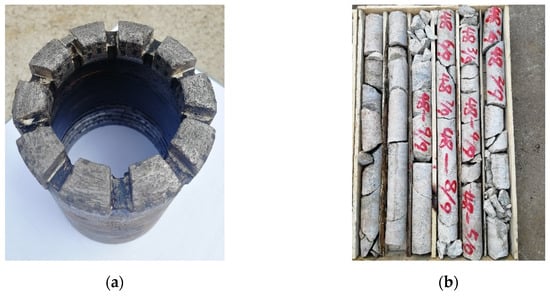
Figure 7.
(a) Wear condition of bit; (b) Retrieved core.
3.3. Test Results of Diamond Core Bit
Figure 8 was the relationship of the WOB and the ROP with the drilling depth. Figure 9 was the relationship of the ROP with the WOB and the RPM. It shows that the independently developed diamond bit has good adaptability to the changing hard rock strata in this area. The average ROP in the test is 4.4 m/h, and the bit life is 137.75 m. During the drilling test, the ROP increased from 2.5 m/h to 4.5 m/h when the WOB decreased from 2.75 t to 1.5 t, and decreased to 4.4 m/h when the WOB increased to 1.75 t. It indicated that when the WOB was 1.5 t, a faster ROP of 4.5 m/h was achieved if coring with a diamond bit.
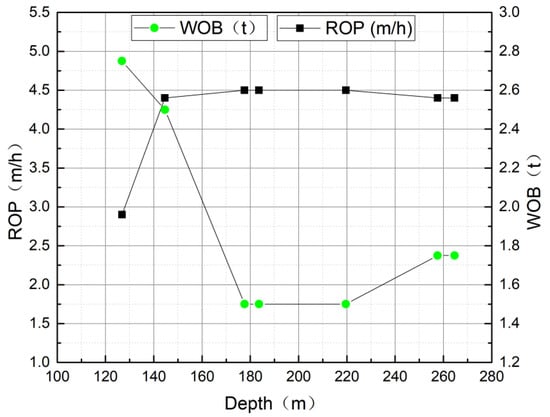
Figure 8.
Relationship of WOB and ROP with drilling depth.
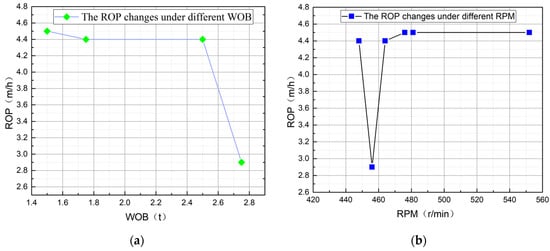
Figure 9.
Data of diamond core bit: (a) The ROP changes under different WOB; (b) The ROP changes under different RPM.
4. Bionic Core Bit
Aiming at the hard and slippery stratum at the bottom of the deep sea, the researchers of the project team carried out relevant research according to the claw toe characteristics of soil animals and used the claw toe of mole cricket as the bionic prototype of single-tooth structure design. The researchers carried out the structure design of the bionic core bit, completed the trial production of the drill bit and field test, and made a comprehensive evaluation of the service life and drilling efficiency, among other indicators [26,27].
4.1. Design of Bionic Core Bit
According to the structure of the mole cricket’s claw toe, the structure of the bionic bit was designed. The inside and outside diameter of the bit was Φ75/215.9 mm, and the tooth thickness of the bit is 69.95 mm. Combined with the strength limit on the material of the bit matrix, 12 cutting teeth were designed, with each tooth setting four coaxial ring tooth units. A total of 12 water outlets were set around the drill bit, each with a width of 10 mm and the thickness of the working layer of 35 mm. The reinforcement ribs were divided into two kinds on the single tooth [28]. Therein, the outer thickness was 4 mm, and the inner thickness was 3 mm and 5 mm, respectively. The inner and outer reinforcement ribs were alternately distributed on the bit surface so that the bit could form as an integrated structure, which could better adapt to the complex environment at the bottom of the hole. This structure could make the force uniform, reduce the destruction caused by the stress concentration, and extend the service life of the drill bit. There was a soft bit matrix layer between the ring teeth. The structure of ring teeth was bionic for the structure of the mole cricket’s claw toe. In the drilling process, the wear resistance of the working layer and the soft bit matrix layer is different. Therefore, the shape of the ring teeth will be automatically formed. The reinforcement rib could break the rock in the form of volume crushing. In this way, the traditional diamond-impregnated rock-crushing mechanism was changed into the form of grinding rock-crushing and volume-crushing simultaneously, which improves the drilling efficiency, as shown in Figure 10.
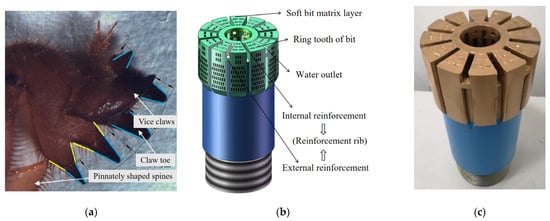
Figure 10.
(a) The claw toe of mole cricket as the prototype bionic; (b,c) The appearance design of bionic core bit (scale 1:10).
4.2. Test Process of Bionic Core Bit
In 2021, the drilling test of the bionic core bit with an outer diameter of 215.9 mm was completed in hard rock in Jilin Province (Figure 11). The design depth of the well was 2879 m, and the section of coring was 2360–2457.4 m. The lithology was gray-green tuff and rhyolite, which had a poor drillability.
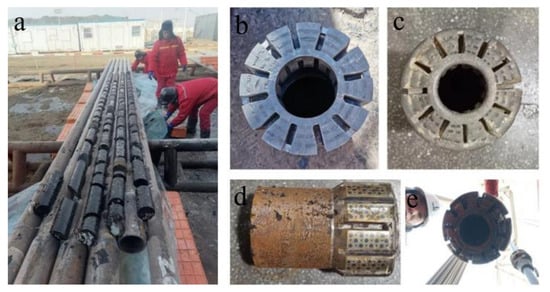
Figure 11.
Drilling test of bionic core bit in hard rock. (a) Recovery core in the test; (b) Drill bit before the test; (c) Drill bit after the test; (d) Side view of the drill bit after testing; (e) Drill bit during lifting down.
A total of seven runs of continuous core drilling were tested. The length of drilling while using the bionic coring drill bit was 97.4 m, and the pure drilling time was 72 h. The average ROP was 1.35 m/h, and the maximum ROP reached 1.88 m/h with a core recovery rate of 100%. The usage of the bit was shown in Table 5 and Figure 12.

Table 5.
Statistics on bit drilling efficiency of bionic core bit.
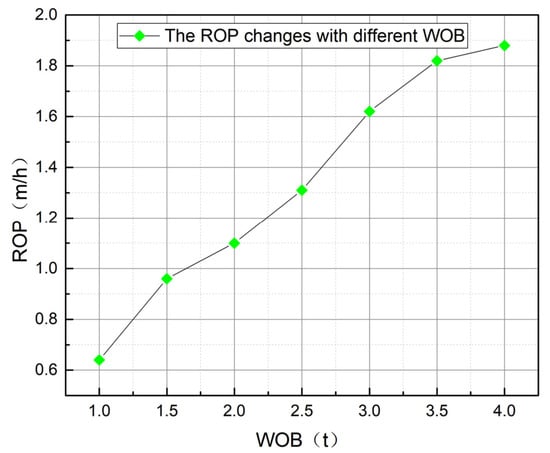
Figure 12.
Relationship between WOB and ROP.
After the test, the inner diameter of the working layer was worn by 5 mm, and the outer diameter was worn by 15 mm. The solution is to increase the effective cutting area of the outer diameter part; that is, to strengthen the reinforcement ribs at the water outlet without affecting the normal circulation of mud.
The field test proved that all the indexes reached the expected target, and it effectively solved the technical problem of efficient drilling in hard rock. The results of the research provided an effective solution for efficient drilling and high-quality coring in deep-sea drilling, which would have a good application value.
According to the above description of the test results, the data comparison of the three bits described in this paper are summarized in Table 6.

Table 6.
Data comparison of three bits.
5. Conclusions
Aiming at a series of problems in deep-sea drilling, such as the low drilling efficiency of hard rock, the short service life of the bit and the poor core quality, three different types of hard rock coring bits were studied in depth, including the roller core bit, diamond core bit and bionic coring drill. Through the extensive land tests and continuous improvement, the average ROP of roller core bits in granite formations could reach 1.2 m/h, and the average core recovery rate was 76.2%. The conventional diamond core bits were tested drilling in granite formations with an average ROP of 1.4 m/h and a service life of 137.75 m. The bionic core bit drilled in tuff and rhyolite with an average ROP of 1.35 m/h and had a core recovery rate of 100%. The length of drilling was 97.4 m and was not yet fully worn. The ROP and service life of the three kinds of drill bits obtained in the field test all meet the technical indexes of deep-sea hard-rock drilling in international ocean drilling, and the diamond bit has the highest mechanical drilling rate of 1.4 m/h and service life of 132.2 m, which is 30% higher than the service life of the bit used in deep-sea hard-rock drilling in international ocean drilling. The test results showed that the core recovery rate of the diamond core bit in hard-rock drilling is higher than that of the roller core bit and the bionic coring drill, which are mainly igneous rocks. However, more sea trials were needed to verify the drill bit. In the future, it is necessary to continue to increase the research and development efforts in the aspects of the drilling tool equipment matching the drill bit, such as the bottomhole-power drive drilling tool, hydraulic hammer drilling tool and wire coring drilling tool, and it is expected to be successfully applied through development in the future.
Author Contributions
Conceptualization, X.L. and W.X.; methodology, X.L., L.X. and W.X.; validation, K.G., Y.S. and Y.C.; formal analysis, X.L., L.X. and W.X.; experiment, K.G., Y.S. and Y.C.; resources, J.Z. and H.Y.; data curation, Y.Y., B.K. and Q.L.; writing—original draft preparation, X.L., L.X. and W.X.; writing—review and editing, X.L. and L.X.; All authors have read and agreed to the published version of the manuscript.
Funding
This research was funded by National Key Research and Development Program of China (grant number 2021YFC2800801) and China Geological Survey (grant number DD20190584).
Institutional Review Board Statement
Not applicable.
Informed Consent Statement
Not applicable.
Data Availability Statement
Not applicable.
Acknowledgments
The authors thank the colleagues of the Hydrate Extraction Engineering Room of Guangzhou Marine Geological Survey and other researchers of project team for their guidance and other help.
Conflicts of Interest
The authors declare no conflict of interest.
References
- Pinxian, W. Fifty years of ocean drilling: Review and prospect. Chin. Sci. Bull. 2008, 63, 3868–3876. [Google Scholar]
- Jianliang, Y.; Wei, Z.; Wenwei, X. Preliminary thoughts on implementation of the ocean drilling projection China. Explor. Eng. (Rock Soil Drill. Tunn.) 2019, 46, 1–8. [Google Scholar]
- Wang, D.; Zhao, G.; Zuo, R.; Sun, J.; Zhou, H.; Zhang, L.; Li, Y. The development and outlook of geological drilling engineering—To review the 70th anniversary of exploration engineering. Explor. Eng. (Rock Soil Drill. Tunn.) 2019, 46, 1–31. [Google Scholar]
- Freudenthal, T.; Wefer, G. Shallow Drilling in the Deep Sea: The Sea Floor Drill Rig MEBO. In Proceedings of the OCEANS 2009—Europe Conference, OCEANS-IEEE 2009, Bremen, Germany, 11–14 May 2009. [Google Scholar]
- Taira, A.; Kuramoto, S. Integrated Ocean Drilling Program (IODP) and research opportunities on deep subsurface biosphere. Geochim. Cosmochim. Acta 2003, 67, A466. [Google Scholar]
- Sewon, C. Fifty Years of Scientific Ocean Drilling (1968–2018): Achievements and Future Direction of K-IODP. J. Korean Soc. Oceanogr. 2019, 24, 30–48. [Google Scholar]
- Ishizuka, O. Outcome of Hard Rock Drilling in the Izu-Bonin Arc. J. Geogr.-Chigaku Zasshi 2021, 130, 527–542. [Google Scholar] [CrossRef]
- Sewon, C.; Sang, M.H. Introduction of New IODP and progress direction of K-IODP. J. Geol. Soc. Korea 2014, 50, 657–669. [Google Scholar] [CrossRef]
- Wada, K. Coring technology to be applied in IODP NanTroSEIZE. In Proceedings of the International Conference OCEANS 2008 and MTS/IEEE Kobe Techno-Ocean ‘08. OCEANS-IEEE, Kobe, Japan, 8–11 April 2008; pp. 610–613. [Google Scholar]
- Kondratenko, A.S.; Timonin, V.V.; Patutin, A.V. Prospects for directional drilling in hard rocks. J. Min. Sci. 2016, 52, 129–134. [Google Scholar] [CrossRef]
- Morishita, T.; Umino, S.; Kimura, J.I.; Yamashita, M.; Ono, S.; Michibayashi, K.; Tominaga, M.; Klein, F.; Garcia, M.O. Workshop report on hard-rock drilling into mid-Cretaceous Pacific oceanic crust on the Hawaiian North Arch. Sci. Drill. 2019, 26, 47–58. [Google Scholar] [CrossRef]
- Chengcheng, N.; Chuanliang, Y.; Deshuai, Z.; Xutian, H.; Yan, C.; Hui, Z. Analysis and Application of a New Hybrid Drill Bit for Use in Hard Rocks. J. Energy Resour. Technol.-Trans. Asme 2022, 144, 123010. [Google Scholar] [CrossRef]
- Sun, B.; Bona, A.; Zhou, B.; van de Werken, M. A comparison of radiated energy from diamond-impregnated coring and reverse-circulation percussion drilling methods in hard-rock environments. Geophysics 2015, 80, K13–K23. [Google Scholar] [CrossRef]
- Shigin, A.O.; Boreyko, D.A.; Tskhadaya, N.D. Comparative Analysis of Roller Drill Bit Performance. Socar Proc. 2022, 2, 1–7. [Google Scholar] [CrossRef]
- Pyalchenkov, V.A.; Kulyabin, G.A.; Dolgushin, V.V. Analytical and experimental study of the deformation of roller cone bit parts. Amazon. Investig. 2019, 8, 23–32. [Google Scholar]
- Zhao, M.; Shao, Y.; Song, G.; Cui, S.; Niu, Q.; Wang, J. Design and application of Ø215.9mm fourcone coring bit. Drill. Eng. 2022, 49, 41–48. [Google Scholar]
- Franca, L.F.P. Drilling Action of Roller-Cone Bits: Modeling and Experimental Validation. J. Energy Resour. Technol.-Trans. Asme 2010, 132, 43101. [Google Scholar] [CrossRef]
- Karasawa, H.; Ohno, T.; Kosugi, M. Methods to estimate the rock strength and tooth wear while drilling with roller-bits-Part 2: Insert bits. J. Energy Resour. Technol.-Trans. Asme 2002, 124, 133–140. [Google Scholar] [CrossRef]
- Krulakova, M.; Krupa, V.; Lazarova, E. Penetration depth as function of thrust force and revolutions in diamond-impregnated core-drilling of hard rocks. In Proceedings of the 16th International Multidisciplinary Scientific Geoconference, SGEM 2016: Science and Technologies in Geology, Exploration and Mining, Albena, Bulgaria, 30 June–6 July 2016; Volume 1, pp. 937–943. [Google Scholar]
- Tan, S.C.; Fang, X.H.; Yang, K.H. A new composite impregnated diamond bit for extra-hard, compact, and nonabrasive rock formation. Int. J. Refract. Met. Mater. 2014, 43, 186–192. [Google Scholar] [CrossRef]
- Sun, Q.B.; Shen, L.N.; Yang, G.S.; Tian, G.L.; Ruan, H.L.; Chen, X. Design and numerical simulation of multi-layer bit with extra-high matrix. Coal Geol. Explor. 2020, 48, 225–230. [Google Scholar]
- Jia, M.L.; Cai, J.P.; Ouyang, Z.Y. Design & Application of Diamond Bit to Drilling Hard Rock in Deep Borehole. Preced. Eng. 2014, 73, 134–142. [Google Scholar] [CrossRef]
- Luzhao, W.; Haixia, W. Research of diamond bit in Wulong Gold Mine, Liaoning Province. Diam. Abras. Eng. 2022, 42, 518–522. [Google Scholar] [CrossRef]
- Jiwei, S.; Lina, S. Effect of WC addition on properties of hot pressed iron base prealloyed powder matrix. Explor. Eng. (RockSoil Drill. Tunn.) 2019, 46, 81–85. [Google Scholar]
- Jichao, Y.; Lina, S.; Hailong, R.; Haixia, W.; Chun, L. Method and Effect of Adding Yttrium Oxide to Diamong Bit Matrix. In Proceedings of the The 20th National Exploration Engineering (Rock and Soil Drilling Engineering) Academic Exchange Conference, Xining, China, 17 September 2019. [Google Scholar]
- Tang, Q.; Guo, W.; Gao, K.; Gao, R.; Zhao, Y.; Sun, Y.; Zhou, Y. Design and test of a self-adaptive bionic polycrystalline diamond compact bit inspired by cat claw. Adv. Mechival Eng. 2018, 10, 1687814018810249. [Google Scholar] [CrossRef]
- Wang, C.L. Bionic design and test of polycrystalline diamond compact bit for hard rock drilling in coal mine. Adv. Mechival Eng. 2020, 12, 1–6. [Google Scholar] [CrossRef]
- Gao, K.; Wang, J.; Zhao, Y.; Zhang, Z.; Xie, X. Bionic self-compensating integrated high-matrix impregnated diamond coring bit. Drill. Eng. 2022, 49, 16–24. [Google Scholar]
Disclaimer/Publisher’s Note: The statements, opinions and data contained in all publications are solely those of the individual author(s) and contributor(s) and not of MDPI and/or the editor(s). MDPI and/or the editor(s) disclaim responsibility for any injury to people or property resulting from any ideas, methods, instructions or products referred to in the content. |
© 2023 by the authors. Licensee MDPI, Basel, Switzerland. This article is an open access article distributed under the terms and conditions of the Creative Commons Attribution (CC BY) license (https://creativecommons.org/licenses/by/4.0/).